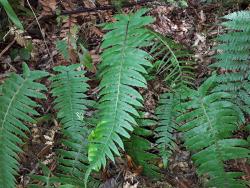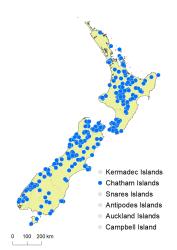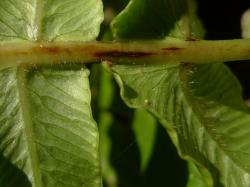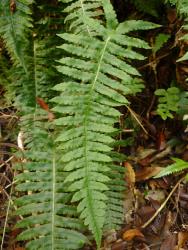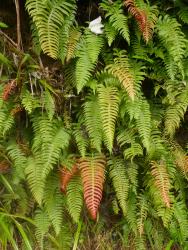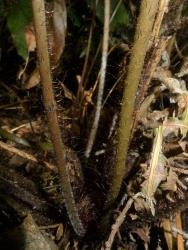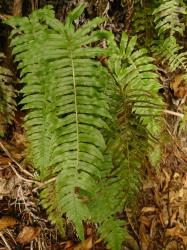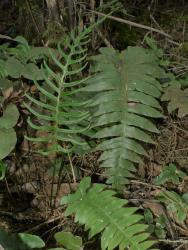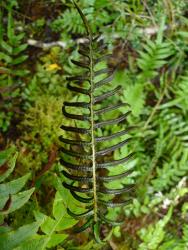- ≡ Lomaria deltoides Colenso, Tasmanian J. Nat. Sci. 1: 376 (1843)
- ≡ Cranfillia deltoides (Colenso) de Lange & Parris, Telopea 22: 154 (2019)
- = Lomaria deflexa Colenso, Tasmanian J. Nat. Sci. 2: 178 (1845)
- = Lomaria paucijuga Colenso, Trans. & Proc. New Zealand Inst. 20: 222 (1888)
Rhizomes erect or short-creeping, up to 190 mm long (in herbarium material), bearing scales. Rhizome scales linear, 7–16 mm long, 0.3–1.0 mm wide, dark brown, concolorous. Fronds strongly dimorphic; fertile and sterile fronds with similar habit, suberect or hanging downwards; sterile fronds 130–1010 mm long; fertile fronds on same plant about equalling the sterile fronds, 130–750 mm long. Sterile fronds. Stipes 50–530 mm long, dark brown proximally, yellow-brown distally, rough, bearing dark brown hair-like scales proximally. Rachises yellow-brown, grooved adaxially, bearing white to fawn-coloured hairs up to 2 mm long. Laminae 75–480 mm long, 35–190 mm wide, deeply pinnatifid to pinnatisect, elliptic or ovate or triangular, with a short apical segment, similar colour on both surfaces, sometimes tinged red when young, coriaceous, abaxial surface and lamina margins hairy or rarely ± glabrous, adaxial surface ± glabrous. Pinnae in 5–30 pairs, closely spaced, oblong, straight or slightly falcate, the basal pair only slightly reduced; the longest pinnae at or below the middle, 17–95 mm long, 6–16 mm wide, apices acuminate or acute or obtuse, margins undulate and shallowly and irregularly dentate, bases adnate; the basal pair opposite, often strongly falcate, tending to point basiscopically. Veins free. Fertile fronds. Stipes 70–410 mm long. Laminae 50–340 mm long, 25–120 mm wide. Pinnae in 8–30 pairs, linear, straight or falcate, the longest 13–75 mm long, 2–5 mm wide, the basal pair only slightly reduced, strongly falcate. Sori and indusia in one row either side of costa, continuous along the length of the pinna.
Blechnum deltoides is distinguished by its dimorphic fronds, free veins, pinnatisect sterile laminae, and continuous sori. The sterile laminae are usually ovate with pinnae that are adnate and reduce in size only slightly at the base of the lamina. The basal pair of pinnae are opposite, often strongly falcate, and tend to point basiscopically. The stipes are rough and bear linear, dark brown scales. The rachises and abaxial surfaces are usually covered in white to fawn-coloured hairs up to 2 mm long, unlike any other New Zealand species, although in a few populations they are glabrous. Fertile and sterile fronds on individual plants are about equal in length. Blechnum deltoides is distinctive amongst the species with pinnatisect sterile laminae in that the basal pinna segments are only slightly reduced.
North Island: Northland, Auckland, Volcanic Plateau, Gisborne, Taranaki, Southern North Island.
South Island: Western Nelson, Sounds-Nelson, Marlborough, Westland, Canterbury, Otago, Southland, Fiordland.
Chatham Islands, Stewart Island.
Altitudinal range: 0–1150 m.
In the North Island Blechnum deltoides is rare north of Auckland and on the east coast, but occurs in lowland and montane areas of the rest of the island south to Wellington. It ranges from near sea level, up to 1150 m on Mt Ruapehu, but is more common above 200 m. It occurs in lowland and montane areas throughout much of the South Island and Stewart Island, but is absent from drier parts of south Canterbury and inland Otago. It grows from near sea level up to nearly 1150 m in the Owen Range, north-west Nelson. It extends also to the Chatham Islands.
Also Australia (Victoria, Tasmania) (Chambers & Wilson 2019).
Blechnum deltoides is usually a terrestrial fern found in podocarp, broadleaved and beech forest, under mānuka and kānuka, in rough pasture, and in subalpine scrub. Very rarely it occurs as a low epiphyte on beech. It grows on rock outcrops and cliffs, on road banks, on stream banks and terraces, on the forest floor, and on banks beside the sea.
n = 34 (Brownlie 1954 – as Blechnum vulcanicum). A count of n = 33 has been reported in Australia (Tindale & Roy 2002 – as Blechnum vulcanicum).
Chambers & Farrant (2012) noted that the taxonomy of the Blechnum vulcanicum aggregate was complex, and that the whole group could either be regarded as one species, or divided into several taxa. Subsequently, Chambers & Wilson (2019) revised the B. vulcanicum group and recognised 13 species in Blechnum sect. Pilosa in Malesia, Australasia and Oceania. Under this classification, accepted here, Blechnum vulcanicum sens. str. was considered to be confined to Malesia, and the species in Australia and New Zealand referred to B. deltoides. Ten other species were recognised in the Pacific region.
Most plants in New Zealand are covered on the abaxial lamina surfaces in white to fawn-coloured hairs. However, Chambers & Wilson (2019) noted that in several populations from the western side of the South Island, as well as those in south-eastern Australia, the hairs on mature fronds were confined to the region of the basal stipe scales.
Chambers & Wilson (2019) argued that WELT P003239, the specimen inadvertently selected as the lectotype of Blechnum deltoides by Allan (1961), should be considered the holotype, with an isotype at Kew (K 001092698). Similarly, they argued that WELT P003238, the specimen inadvertently selected as lectotype of B. deflexa by Allan (1961), is the holotype, and K 001092697 the isotype. They state that “The documentation presented by St George (2009: 163) indicates unquestionably that the specimens of both taxa sent by Colenso to Hooker were part of the same gathering as those in WELT”.
However, in designating lectotypes in this Flora, we have consistently taken the view that Colenso’s collections in K and WELT cannot be assumed to be from the same gathering, and must therefore be considered syntypes. Even if they could be shown to be from the same gathering, it is not possible to say which is the holotype, and which the isotype. Colenso never indicated a holotype, nor the herbarium where the specimen was deposited. Furthermore, in this particular instance the type specimens of Blechnum deltoides and B. deflexa are mounted on the same sheet, and it is far from clear which label relates to which specimens. The label for Lomaria deltoides appears to relate to the frond at the bottom of the sheet, but the Kew barcode has been applied so that it also includes the right-hand specimen. When compared to the specimens at WELT, the fronds of L. deflexa at K are much larger, and almost certainly did not come from the same gathering. This raises the possibility that the labels on the Kew sheet may have become muddled. Whatever the real history of these specimens, it seems safer to accept Allan’s lectotypifications of the specimens at WELT, which are clearly segregated on different sheets.



